Never miss another geomagnetic storm. Sign up for Space Weather Alerts and you'll receive a text message when auroras appear in your area. Aurora tour guides and professional astronomers use this service. Now you can, too! | | |
SOLAR MINIMUM CONDITIONS ARE IN EFFECT: Solar Minimum doesn't give up easily. For much of July and August, it seemed like solar activity was returning to normal, with a profusion of Solar Cycle 25 sunspots and minor solar flares. But now the sun is blank again--no sunspots--and the sun's X-ray output has flatlined. Periods of quiet like these will crop up from time to time as Solar Cycle 25 sputters to life. Aurora alerts: SMS Text.
SPIRAL LIGHTS ON MARS: NASA's MAVEN spacecraft has discovered something unexpected on Mars--and researchers are struggling to explain it.
"There is a vast spiral of ultraviolet light over Mars' South Pole," says Nick Schneider of the University of Colorado's Laboratory for Atmospheric and Space Physics. "We understand the origin of the light, but its shape is a mystery."
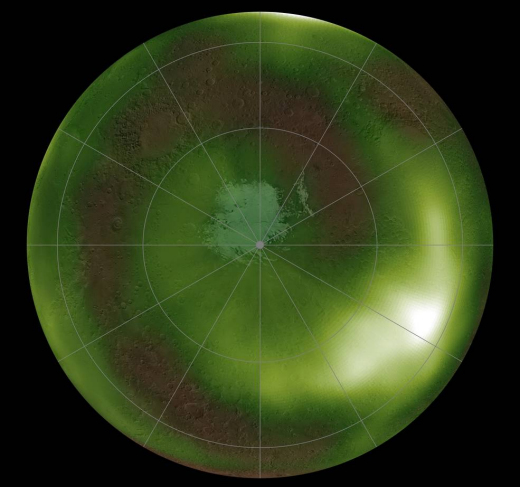
Above: Shown in false-color (green), UV light is spiraling around Mars' South Pole.
The light is "nightglow." We have it here on Earth, too, where it's called "airglow." During the day, ultraviolet radiation from the sun breaks apart compounds in the upper atmosphere. At night, the atoms reassemble, glowing as they put themselves back together again. On Earth, airglow looks like the aurora borealis; people can actually see it. On Mars, the emission is ultraviolet, invisible to the human eye.
MAVEN has been monitoring Martian nightglow for years, yet the spiral pattern was only recently recognized. Schneider recalls the 'Eureka moment': "We were preparing a demo on our lab's internal projection sphere (like Science on a Sphere), which turned out to be the first time we had plotted the UV glow in polar coordinates. The spiral 'popped' and we were all quite giddy."
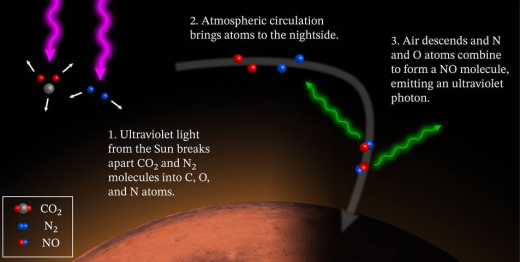
Above: The chemistry of Martian nightglow. Nitric oxide (NO) also produces airglow on Earth.
The spiral is just the tip of the iceberg; the whole planet is surrounded by pulsating patterns of nightglow. High above the North Pole of Mars there is a luminous blob that pulses exactly twice a day. And around the equator there are three more blobs, evenly spaced, pulsing three times a day. Only the South Pole has a spiral, and it pulses once a day.
"It's pretty complicated," says Schneider.
To make sense of it all, Schneider and colleagues "spun up" a general circulation model (GCM) of the Martian atmosphere. (This part of the work was led by Francisco González‐Galindo at the Instituto Astrofísica Andalucía.) GCMs are computer programs that model planetary atmospheres. They're used all the time by weather forecasters on Earth, and planetary scientists have Martian versions as well, complete with accurate values for solar heating, winds, chemistry, cloud formation, and so on.
According to the GCM, nightglow on Mars is shaped by atmospheric tides. The gravity of the sun pulls on the Martian atmosphere, and the atmosphere has a natural response: It essentially rings like a bell three times a day. This accounts for the pulsating blobs around the equator.
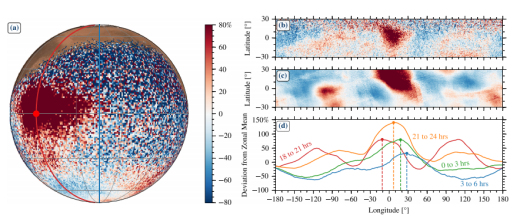
Above: MAVEN data (panels a and b) vs. a GCM model of Martian nightglow (panel c).
"We were really impressed that the Mars General Circulation Model reproduced the equatorial patterns so well," says Schneider. The model did not, however, account for the spiral. "We've really struggled to explain it," he admits. "And however we might explain why a spiral should exist at the South Pole, we also need to explain why it should not exist at the North Pole!"
More data from MAVEN and updates to the Mars General Circulation Model might eventually provide an answer. For now, it remains a dizzying mystery. Schneider et al's original research was just published in the August 6, 2020, edition of JGR Space Physics. Read it here.
Realtime Space Weather Photo Gallery
Free: Spaceweather.com Newsletter
DARTH VADER BOBBLEHEAD: No collection of Star Wars bobbleheads is complete without a Sith Lord. For those of you who feel the same way, we present Darth Vader in the stratosphere. On Aug. 14th, Luke's father hitched a ride onboard an Earth to Sky Calculus cosmic ray balloon, flying 117,454 feet above Earth's surface:
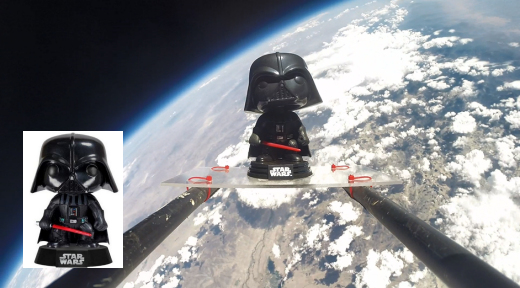
You can have him for $119.95. The students of Earth to Sky Calculus are selling Vader bobbleheads to fund their cosmic ray monitoring program. Each one comes with a greeting card showing Vader in flight and telling the story of his journey to the edge of space and back again.
Far Out Gifts: Earth to Sky Store
All sales support hands-on STEM education
Realtime Aurora Photo Gallery
Free: Spaceweather.com Newsletter.
Every night, a network of
NASA all-sky cameras scans the skies above the United States for meteoritic fireballs. Automated software maintained by NASA's Meteoroid Environment Office calculates their orbits, velocity, penetration depth in Earth's atmosphere and many other characteristics. Daily results are presented here on Spaceweather.com.
On August 25, 2020, the network reported 27 fireballs.
(27 sporadics)
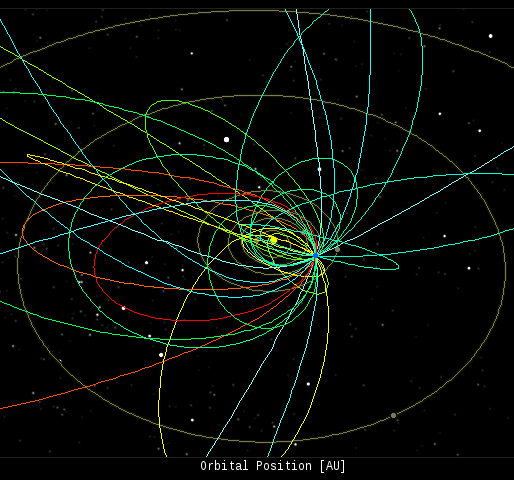
In this diagram of the inner solar system, all of the fireball orbits intersect at a single point--Earth. The orbits are color-coded by velocity, from slow (red) to fast (blue). [Larger image] [movies]
Potentially Hazardous Asteroids (
PHAs) are space rocks larger than approximately 100m that can come closer to Earth than 0.05 AU. None of the known PHAs is on a collision course with our planet, although astronomers are finding
new ones all the time.
On August 25, 2020 there were 2037 potentially hazardous asteroids.
 |
Recent & Upcoming Earth-asteroid encounters: | Asteroid | Date(UT) | Miss Distance | Velocity (km/s) | Diameter (m) |
| 2020 QW3 | 2020-Aug-20 | 8.2 LD | 18 | 30 |
| 2020 QO1 | 2020-Aug-20 | 3.7 LD | 26.5 | 13 |
| 2020 PY2 | 2020-Aug-20 | 0.9 LD | 16.8 | 17 |
| 2020 QY2 | 2020-Aug-20 | 0.2 LD | 18.9 | 2 |
| 2020 PQ2 | 2020-Aug-21 | 4.6 LD | 19.7 | 50 |
| 2020 QN4 | 2020-Aug-21 | 0.7 LD | 7.7 | 7 |
| 2020 QP | 2020-Aug-21 | 16.1 LD | 24.7 | 56 |
| 2020 QQ4 | 2020-Aug-22 | 0.8 LD | 7.6 | 6 |
| 2020 QF | 2020-Aug-23 | 9 LD | 6.9 | 13 |
| 2020 QT4 | 2020-Aug-23 | 5.4 LD | 8.3 | 31 |
| 2020 FA1 | 2020-Aug-23 | 18.4 LD | 1.9 | 20 |
| 2020 QD1 | 2020-Aug-23 | 10.1 LD | 13.5 | 16 |
| 2020 PP3 | 2020-Aug-24 | 16.2 LD | 9.5 | 36 |
| 2020 PJ6 | 2020-Aug-24 | 13.9 LD | 3.3 | 27 |
| 2020 QE5 | 2020-Aug-24 | 17.9 LD | 9.1 | 29 |
| 2020 QE2 | 2020-Aug-25 | 20 LD | 12.6 | 35 |
| 2020 QP1 | 2020-Aug-25 | 19.6 LD | 8.7 | 20 |
| 2016 AH164 | 2020-Aug-26 | 15.7 LD | 5.6 | 4 |
| 2020 PF3 | 2020-Aug-26 | 6.4 LD | 9.6 | 25 |
| 2020 QQ2 | 2020-Aug-27 | 8.6 LD | 6.2 | 16 |
| 2020 QG5 | 2020-Sep-01 | 7.8 LD | 14.2 | 25 |
| 2011 ES4 | 2020-Sep-01 | 0.3 LD | 8.2 | 30 |
| 2020 PG6 | 2020-Sep-02 | 5.9 LD | 6.6 | 14 |
| 465824 | 2020-Sep-06 | 19.4 LD | 14 | 162 |
| 2020 PT4 | 2020-Sep-08 | 4.9 LD | 12.6 | 37 |
| 2012 RM15 | 2020-Sep-12 | 14.9 LD | 9.8 | 45 |
| 2017 US | 2020-Sep-13 | 17.3 LD | 5.9 | 21 |
| 2020 QL2 | 2020-Sep-14 | 17.9 LD | 10.6 | 70 |
| 2014 QJ33 | 2020-Sep-18 | 11.5 LD | 8.3 | 65 |
| 2017 SL16 | 2020-Sep-20 | 8.9 LD | 6.4 | 25 |
| 2001 GP2 | 2020-Oct-01 | 6.1 LD | 2.2 | 15 |
| 2010 UC | 2020-Oct-04 | 14.6 LD | 3.2 | 12 |
| 2019 SB6 | 2020-Oct-07 | 11.9 LD | 7.6 | 16 |
| 2018 GD2 | 2020-Oct-13 | 16.4 LD | 6.7 | 5 |
| 2017 UH5 | 2020-Oct-20 | 8.9 LD | 5.9 | 18 |
| 2018 VG | 2020-Oct-21 | 15.1 LD | 6.7 | 12 |
Notes: LD means "Lunar Distance." 1 LD = 384,401 km, the distance between Earth and the Moon. 1 LD also equals 0.00256 AU. MAG is the visual magnitude of the asteroid on the date of closest approach. | | Cosmic Rays in the Atmosphere |
SOMETHING NEW! We have developed a new predictive model of aviation radiation. It's called E-RAD--short for Empirical RADiation model. We are constantly flying radiation sensors onboard airplanes over the US and and around the world, so far collecting more than 22,000 gps-tagged radiation measurements. Using this unique dataset, we can predict the dosage on any flight over the USA with an error no worse than 15%.
E-RAD lets us do something new: Every day we monitor approximately 1400 flights criss-crossing the 10 busiest routes in the continental USA. Typically, this includes more than 80,000 passengers per day. E-RAD calculates the radiation exposure for every single flight.
The Hot Flights Table is a daily summary of these calculations. It shows the 5 charter flights with the highest dose rates; the 5 commercial flights with the highest dose rates; 5 commercial flights with near-average dose rates; and the 5 commercial flights with the lowest dose rates. Passengers typically experience dose rates that are 20 to 70 times higher than natural radiation at sea level.
To measure radiation on airplanes, we use the same sensors we fly to the stratosphere onboard Earth to Sky Calculus cosmic ray balloons: neutron bubble chambers and X-ray/gamma-ray Geiger tubes sensitive to energies between 10 keV and 20 MeV. These energies span the range of medical X-ray machines and airport security scanners.
Column definitions: (1) The flight number; (2) The maximum dose rate during the flight, expressed in units of natural radiation at sea level; (3) The maximum altitude of the plane in feet above sea level; (4) Departure city; (5) Arrival city; (6) Duration of the flight.
SPACE WEATHER BALLOON DATA: Approximately once a week, Spaceweather.com and the students of Earth to Sky Calculus fly space weather balloons to the stratosphere over California. These balloons are equipped with radiation sensors that detect cosmic rays, a surprisingly "down to Earth" form of space weather. Cosmic rays can seed clouds, trigger lightning, and penetrate commercial airplanes. Furthermore, there are studies ( #1, #2, #3, #4) linking cosmic rays with cardiac arrhythmias and sudden cardiac death in the general population. Our latest measurements show that cosmic rays are intensifying, with an increase of more than 18% since 2015:

The data points in the graph above correspond to the peak of the Regener-Pfotzer maximum, which lies about 67,000 feet above central California. When cosmic rays crash into Earth's atmosphere, they produce a spray of secondary particles that is most intense at the entrance to the stratosphere. Physicists Eric Reneger and Georg Pfotzer discovered the maximum using balloons in the 1930s and it is what we are measuring today.
En route to the stratosphere, our sensors also pass through aviation altitudes:

In this plot, dose rates are expessed as multiples of sea level. For instance, we see that boarding a plane that flies at 25,000 feet exposes passengers to dose rates ~10x higher than sea level. At 40,000 feet, the multiplier is closer to 50x.
The radiation sensors onboard our helium balloons detect X-rays and gamma-rays in the energy range 10 keV to 20 MeV. These energies span the range of medical X-ray machines and airport security scanners.
Why are cosmic rays intensifying? The main reason is the sun. Solar storm clouds such as coronal mass ejections (CMEs) sweep aside cosmic rays when they pass by Earth. During Solar Maximum, CMEs are abundant and cosmic rays are held at bay. Now, however, the solar cycle is swinging toward Solar Minimum, allowing cosmic rays to return. Another reason could be the weakening of Earth's magnetic field, which helps protect us from deep-space radiation.
| | The official U.S. government space weather bureau |
| | The first place to look for information about sundogs, pillars, rainbows and related phenomena. |
| | Researchers call it a "Hubble for the sun." SDO is the most advanced solar observatory ever. |
| | 3D views of the sun from NASA's Solar and Terrestrial Relations Observatory |
| | Realtime and archival images of the Sun from SOHO. |
| | from the NOAA Space Environment Center |
| | fun to read, but should be taken with a grain of salt! Forecasts looking ahead more than a few days are often wrong. |
| | from the NOAA Space Environment Center |
| | the underlying science of space weather |
 | To find reviews of new online casino sites in the UK try The Casino DB where there are hundreds of online casino reviews complete with bonuses and ratings. Get a bonus when playing at a new casino in the UK. The Genie got you covered! Looking for a new online casino? Try Casimpo the new site dedicated to making online casino simple, or check out the new Avenger Slots Casino and Slot Strike Casino Sites with over 500 online slots and casino games. . |
| | These links help Spaceweather.com stay online. Thank you to our supporters! |
| | | | | | |

